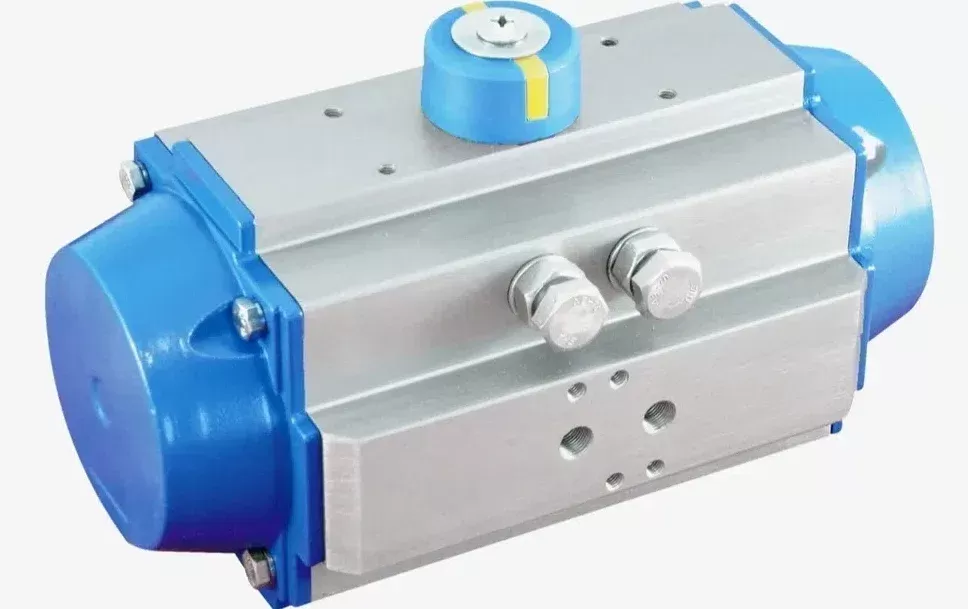Notifications

7 minutes, 27 seconds
-32 Views 0 Comments 0 Likes 0 Reviews

Introduction
Pneumatic rotary actuators are vital components in industrial automation, converting compressed air energy into controlled rotary motion. They are commonly used to automate quarter-turn China Control Valves such as butterfly and ball valves across a variety of industries—including oil and gas, water treatment, power generation, and chemical processing.
These actuators rely on clean, dry compressed air to deliver fast and reliable motion, especially in environments where electric actuators may pose safety risks or prove ineffective. Typically, air is supplied from a centralized compressor, although process gas can sometimes be used. Exhaust air is either vented to the atmosphere or routed to a lower-pressure system to enhance efficiency.
This article delves into the structure, working principles, types, advantages, and applications of pneumatic rotary actuators.
What is a Pneumatic Rotary Actuator?
A pneumatic rotary actuator transforms compressed air into rotational motion. It consists of internal chambers where air pressure acts on a piston or diaphragm. If the internal movement is linear, it’s converted into rotary motion using mechanical linkages such as gears or yokes.
These actuators are favored for their durability, high torque-to-weight ratio, and suitability in hazardous environments where sparks from electrical components could be dangerous.
Working Principle
The fundamental operation involves directing compressed air to internal components—either a piston or vane—to generate torque. Depending on the design, air can be applied to one side (single acting) or both sides (double acting) of the component.
Single Acting: Air pressure moves the actuator in one direction, while a spring returns it to its original position when air is released.
Double Acting: Air pressure is alternated on both sides of the piston to produce bi-directional motion, ideal for more frequent and controlled operations.
The resulting rotation drives valves or other mechanical systems in automated processes.
Types of Pneumatic Rotary Actuators
Vane Actuators
These feature a central rotor with vanes that rotate when air pressure is applied to one side. Torque is generated by the pressure differential across the vanes.
Pros:
Compact and lightweight
Quick actuation
Simple design and low cost
Cons:
Limited torque output
Wear on seals
Usually limited to 90° or 180° rotation
Rack and Pinion Actuators
A linear piston drives a straight gear (rack), which turns a round gear (pinion) to create rotary motion.
Pros:
Balanced torque and control
Compact with precise movement
Available in single and double acting options
Cons:
Requires regular lubrication
Potential gear wear over time
Scotch Yoke Actuators
These use a yoke mechanism to convert linear piston movement into rotary motion, delivering high torque at the beginning and end of the stroke.
Pros:
High breakaway torque
Excellent for demanding applications
Suited for harsh environments
Cons:
Larger and heavier
Non-linear torque output
Diaphragm-Style Rotary Actuators
Use flexible diaphragms instead of pistons. These are common in clean, sensitive processes.
Pros:
Smooth, precise movement
Fewer moving parts
Ideal for corrosive or sterile environments
Cons:
Limited torque
Less suitable for large or customized applications
Single Acting vs. Double Acting Actuators
Single Acting (Spring-Return)
These actuators use air pressure in one direction and a mechanical spring to return the actuator to its fail-safe position.
Advantages:
Fail-safe operation
Lower air consumption
Best for:
Emergency shut-off valves
Safety-critical systems
Double Acting
Compressed air is used for both directions, enabling better control and more consistent torque.
Advantages:
Higher torque output
Greater control and efficiency
Best for:
High-cycle applications
Precision control needs
Key Considerations When Choosing a Pneumatic Rotary Actuator
Torque Requirements:
Must cover breakaway, running, and seating torque to ensure reliable operation.
Rotation Angle:
Choose actuators offering the necessary travel—typically 90°, 120°, or 180°.
Speed of Operation:
Critical for fast-acting systems like emergency shutdowns.
Environmental Conditions:
Consider factors like temperature, corrosion, and explosion risks. Ensure compliance with standards like ATEX and ISO.
Mounting and Compatibility:
Confirm compatibility with valve interfaces (e.g., ISO 5211). Look for adjustable or standardized mounting options.
Applications of Pneumatic Rotary Actuators
These actuators are used across a wide array of industries due to their versatility and performance:
Oil & Gas: Pipeline valve automation, blowdown systems
Water & Wastewater: Flow control in treatment plants
Power Generation: Steam and cooling systems
Chemical Industry: Handling aggressive or hazardous media
Food & Beverage: Hygienic, clean-room automation
Pharmaceuticals: Sterile, repeatable motion in production
Advantages of Pneumatic Rotary Actuators
Fast Response: Quick reaction to control signals
Reliable in Harsh Conditions: Ideal for explosive or corrosive environments
Low Maintenance: Simple construction with fewer components
Cost-Effective: Lower initial and operating costs—especially in air-equipped facilities
Limitations
Air Supply Dependency: Requires a clean, consistent compressed air source
Lower Energy Efficiency: Compared to electric systems in long-term operations
Control Precision: Typically less refined than electric or servo systems
Emerging Trends and Innovations
Pneumatic actuators are evolving with smarter technologies:
Positioners and Smart Controllers: Improve accuracy and diagnostics
IoT Integration: Enables predictive maintenance and remote control
Energy Recovery: Enhances efficiency by reclaiming exhaust energy
Hybrid Designs: Merging pneumatic, electric, and hydraulic elements for optimized performance
Conclusion
Pneumatic rotary actuators remain indispensable in modern automation, offering a winning mix of speed, durability, and safety. Understanding the various types, their operation, and application suitability helps ensure optimal selection and deployment.
As industries push toward smarter, more connected systems, pneumatic actuators are evolving to offer traditional reliability with modern intelligence—making them more valuable than ever in the journey toward industrial efficiency and innovation.Know more about Google SEO Directory
China EV Chargers EV Charger Manufacturer EV Charging Solutions

